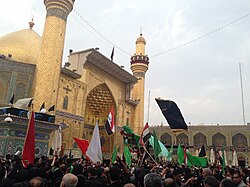Islam in Iraq
 From Wikipedia - Reading time: 11 min
From Wikipedia - Reading time: 11 min
| Islam by country |
|---|
 |
|
|
The history of Islam in Iraq goes back almost 1,400 years to the lifetime of Muhammad (died in 632). Iraq's 98% majority Muslims follow two distinct traditions: Shia Islam (55-60%) and Sunni Islam (35-40%).[1] Islam is the state religion of the Republic of Iraq.
History
[edit]This section needs expansion. You can help by adding to it. (March 2024) |
Religious cities
[edit]Iraq is home to many religious cities important for both Shia and Sunni Muslims. [2]Baghdad was a hub of Islamic learning and scholarship for centuries and served as the capital of the Abbasids.[3] Baghdad also is home to two prominent Shia Imams in what is known as Kadhimiya, Iraq. The city of Karbala has substantial prominence in Shia Islam as a result of the Battle of Karbala, fought in 10 October 680. Similarly, Najaf is renowned as the site of the tomb of Alī ibn Abī Tālib (also known as "Imām Alī"), whom the Shia consider to be the righteous caliph and first imām. The city is now a great center of pilgrimage from throughout the Shi'a Islamic world and it is estimated that only Mecca and Medina receive more Muslim pilgrims. The city of Kufa was home to the famed scholar Abu Hanifah, whose school of thought is followed by many Sunni Muslims internationally. Kufa was also the capital of the Rashidun Caliphate during the time of Ali. Likewise, Samarra is also home to the al-Askari Mosque, containing the mausoleums of the Ali al-Hadi and Hasan al-Askari, the tenth and eleventh Shia Imams respectively, as well as the maqam (or "point") of Muhammad al-Mahdi, who is the twelfth and final Imam of the Shia Madhhab. This has made it an important pilgrimage centre for Ja'farī Shia Muslims. In addition, some female relatives of Muhammad are buried in Samarra, making the city one of the most significant sites of worship for Shia Muslims and a venerated location for Sunni Muslims. Iraq was also the place of many the fitnas (schisms) that occurred in the beginning.
Demographics
[edit]The data on the religious affiliation of Iraq's population are uncertain. 95–99% of the population are Muslims.[4][5] The CIA World Factbook reported a 2015 estimate according to which 36–39% were Sunni Muslims and 61-64% Shia Muslims.[4] According to a 2011 survey by Pew Research, 51% of the Muslims identified as Shia and 42% as Sunni.[5] David Smock of the United States Institute of Peace stated in 2003 that Shiites constituted about 55-60 percent of the Muslim population and Sunnis represented 35-40 percent.[6]
Islam in law
[edit]This section needs expansion. You can help by adding to it. (July 2023) |
In 1968 the Ministry of the Interior had a prohibition on miniskirts, stating that sharia was one reason why.[7]
Gallery
[edit]-
Shia commemorating Muharam in the holy city of Karbala
-
The spiral minaret of the Great Mosque of Samarra
See also
[edit]References
[edit]- ^ "Religious Politics in Iraq". United States Institute of Peace. Retrieved 30 January 2024.
- ^ The Legacy of Iraq: From the 2003 War to the 'Islamic State'. Edinburgh University Press. 2015. doi:10.3366/j.ctt16r0j1w. ISBN 978-0-7486-9616-1.
- ^ "Al-Jami'ah: Journal of Islamic Studies". aljamiah.or.id. Retrieved 12 October 2024.
- ^ a b "CIA World Fact Book". 21 April 2021. Retrieved 25 April 2021.
- ^ a b Michael Lipka (18 June 2014). "The Sunni-Shia divide: Where they live, what they believe and how they view each other". Pew Research Center. Retrieved 15 April 2021.
- ^ "Religious Politics in Iraq". United States Institute of Peace. Retrieved 21 April 2024.
- ^ "Iraqi Girls Warned". The Des Moines Register. Des Moines, Iowa: Associated Press. 28 December 1968. p. 7. - Clipping at Newspapers.com.
 KSF
KSF



